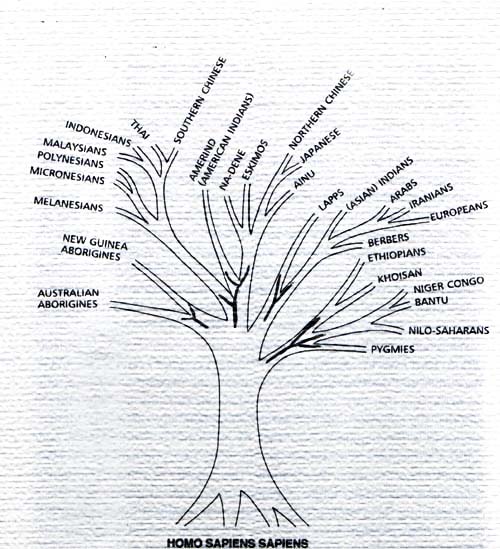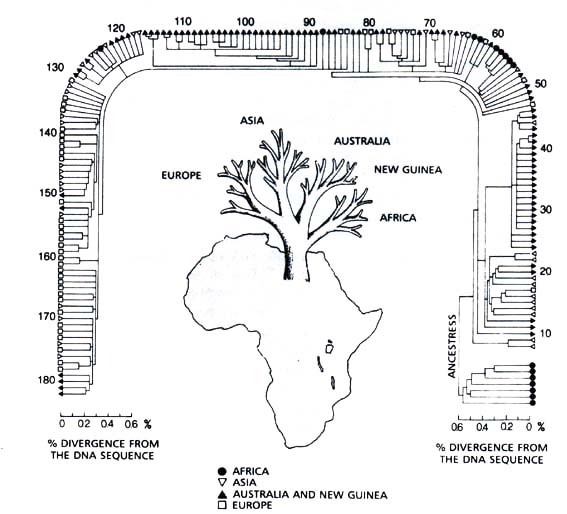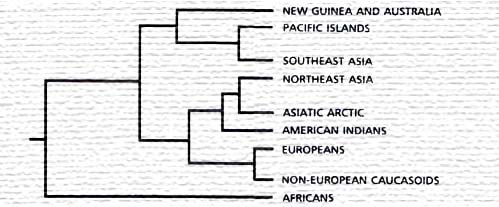|
|
It all boils down to how you define race and if you want to lump all of the human species into one race, the human race, or split the human species up based on genetic information shown below, and then call these "races," "breeds" or "types."
A lot of this material can't be found anymore, or people say they can't find it, or it's hard to find, or you have to pay or be subscribed to a journal to find it. People that do find it often misrepresent what it's saying, either by using it to emphatically deny that any races exist, or by using it to emphatically prove that races do exist.
Again, whether or not you divide the human species up into groups or not is a matter of semantics as far as the doctrines of the SR Organization go: we don't care. Otherwise, the rest of the argument is purely political with each side calling the other side names like "Nazi," "Hitlerite," "racist," versus "Communist," lysenkoist," "politically correct," "thought police," and so forth. Translation: they flame each other.
Every ethnic group knows it's an ethnic group with its own culture, values, language, food, music and etc., and they usually do see themselves as different from people with different cultures. No one disputes that ethnic groups and cultures exist - but this is not the same things as referred to above.
And so, SR is going to simply show you what's out there with diagrams and a few basic quotes of data only, from the sources.
THE GREAT TREE OF HUMANITY

Notice the branches on this Great Tree. You can lump all of it together to get The Human Race, or you can split it up, just as the branches are split up, and call these branches races, breeds, or whatever. You can split the tree up using the 4 major branches shown, or split it further by showing 9 or 10 smaller splits in the branches, or go for broke and split this up into 27 groups.
THE HORSE SHOE DIAGRAM

This is Allan Wilson and his team's tree.
From The Great Human Diasporas by Cavalli-Sforza, chapter heading: "When Did the Races of Humanity Separate," they are speaking about calculating the relationship between the date of arrival on a certain continent and the genetic distance between the two groups (or more) that result from that separation. Here is a TABLE of four comparisons of genetic distance among human populations. The maximum distance shown would be between "H sapiens that were in African and stayed in Africa" and "H. sapiens that left Africa," referred to as Africans and Non-Africans in his book. Here's the problem with such semantics: that way of referring to humans in a specific location is confusing, because most people conjure up an image of a human being from that location today instead of seeing simply an ancient location with H. sapiens on it! These are the genetic distances that correspond to the forks on the image in FIGURE 5.4 of his book, shown below. When you see the table, envision places and try not to envision people from those locations today.
TABLE
| Separation of People | Date | Genetic Distance |
| Africa & the rest of the world | 100,000 years ago | 100 |
| SE Asia & Australia | 55-60,000 years ago |
62 |
| Asia & Europe | 35-40,000 years ago | 48 |
| NE Asia & America | 15-35,000 years ago | 30 |
Genetic distance among people increases with separation time. The table shows a progression showing that the smaller the period of time since separation, the smaller the genetic distance.
FIGURE 5.4

This is a genetic tree of the world's population based on 100 genes, all of which are blood groups, proteins, enzymes and so on. This is drawn from History and Geography of Human Genes, Princeton, Univ. Press, 1984.
What this is clearly showing is a first separation in populations: Africans are split apart from everyone else. Next, there is another split but it is among the non-African populations, which form two main groups:
#1. You can see Non-European Caucasoids, Europeans, American Indians, Asiatic Arctic people and Northeast Asians are in one related non-African group.
#2. You can see Southeast Asians, Pacific Islanders, New Guinea and Australian Aborigines are in another related non-African group.
Next,
group #1 is further split so that you get this grouping:
#1a.
Europeans and non-European Caucasoids are together.
#1b.
Asiatic Arctic, Northeast Asians and American Indians are together.
And
group #2 is further split so that you get this grouping:
#2a. Southeast Asia
and Pacific Island people are together.
#2b. New Guinea and Australian Aborigines
are together.
Genetics Org has Haplotype information. Or do a search on the word "haplotype," for more. This is much more detailed on these matters where they show which groups of people share haplotypes; however this information is not easy to interpret and certain matters are not emphasized, or are even glossed over, while other matters are emphasized. For an example, all Asian and the majority of European sequences studied are of haplotype A, which is also present in one of the Nigerian African sequences. Haplotype B is the major haplotype among Africans but is also observed in three Italian sequences. Thus, both major haplotypes (A and B) are shared by Africans and non-Africans. Also haplotype C, which is found in a Sardinian, can also be counted as shared because it differs from haplotype B by only one mutation. Where the authors say, "of course, this presence may represent recent immigration from Africa to nearby Italy," it simply implies that they don't know any Mediterranean history. Obviously, the African haplotype is going to be found among Mediterranean countries known for the slave trade of antiquity. However it is not found at all among groups of people that had moved further away. That is important information, yet it is glossed over.
What is far more interesting is the authors' finding, again glossed over, that, "there is no nucleotide variation among the Asians studied." That is to say, no African haplotypes found in the Asian sample. All that means is that there was no contact, or very little, after they moved away so many thousands of years ago.
It's things like this (what gets glossed over and/or what gets emphasized and even how some things are made to sound - misleading) that make people who wish to divide man into races believe that the information is being slanted or veiled or outright not entirely discussed. Also, these are estimates with samples from these populations. Even if they sample 1,000 people, that's hardly enough! They have not sampled every human being alive.
So, is there such a thing as race? Yes? No? Maybe?
If you use the same identical criteria for humans as you use for dogs and cats, well then, dogs and cats come in breeds that are named and identified based on their appearance and behavior. If you use that criteria, then humans do come in breeds! Is there a Woof or Meow in protest to that? An interesting note: in a Russian experiment involving selection of foxes, the only criteria for selecting foxes out to breed separately was behavior. Friendly foxes were selected out of a group of wild foxes. Within a few generations, the scientists bred foxes that were a lot friendlier in behavior - but something unexpected happened. The friendly breed of foxes look different enough from the other wild foxes that - if they were two groups of humans - they would be called "two races." After 40 years of selective breeding, Russian scientists have produced a friendly fox that whines for attention from humans, licks its master's face, and has even begun looking like a dog. "They have shown themselves to be good-tempered creatures, as devoted as dogs but as independent as cats," writes geneticist Lyudmila Trut in the journal American Scientist. "Both Belyaeve and Trut selected foxes for one criterion only – tameness, which was evaluated by the foxes' reactions to their human keepers. If they were vicious, they didn't join the experimental population. If they showed slight fear and friendliness, they did. To ensure that their tameness resulted from genetic selections, the scientists didn't train the foxes and their contact with humans was limited to brief, behavioural tests." (see full issue: American Scientist, March-April 1999 Volume: 87 Number: 2 Page: 160 DOI: 10.1511/1999.2.160)
So it appears that behavior and appearance go hand in hand with each other, for the most part! That would certainly account for stereotypes that humans tend to make. Humans use eyesight as their main sense organ for identification.
The SR Organization does not ask you what your race or ethnic culture is or what you look like; SR Organization does not ask you what gender you are; SR doesn't ask you how old you are; though SR has to ask if you are 18 or have adult permission to join, for legal purposes. SR doesn't care about superficial matters. SR considers that life is life, all sentient. SR recognizes that every individual living thing, not just human, is unique and individual while, at the same time, it is part of the Great Web of Life and interconnected. SR recognizes no superiority or inferiority between the PHYLUM that exist. All is LIFE, all has Being, all are Becoming, All things, including the cosmos, came from the Boundless Darkness - and all things return to that.
There are people interested in this genetic data because of their true Eros for Knowledge about the wonderful and infinite variations in life in general. It is with this spirit that this information is being put up here (and because a few folks asked me to do it….)
1/22/04 - Over and Out - TJ
Other sites:
Ancestry by DNA: Find out how to get a test!
Unfortunately, these links below are gone - but this is what used to be there.
http://www.racearchives.com/archived/ used to be there. The NEWS Division of Race Archives specialising on Human Biodiversity issues such as Evolution, Genetics, Anthropology, and Archaeology. Updated almost daily, the site has been our most popular feature.
http://www.racearchives.com/pdf_archive/ used to be there. Released monthly, the PDFs contain each month's news articles in one neat package. The site should be useful for those who wish to store the news articles - for personal consumption, in neat, printable PDF documents.
http://www.racearchives.com/calc/ used to be there. The ANTHROPOLOGIC Division of Race Archives specialising on data that are collected from published sources. Often the frequency of Anthropometric or Biological traits are computed, using mathematical formula, to "calculate" the distances between World populations. Though the distances are relative to each other, the site may be of great use just because of the data presented in one neat site. The site is one of its kind on the web.
Unfortunately, these sites are gone.
Can the phenotype of an individual be discerned by skeletal remains or, specifically, the just the skull?
Race, as defined for purposes of forensics, can be determined by midfacial measures alone with an accuracy of some 80% or above. Given a complete skeleton, we would be looking at somewhere around 98%.
Of course, the forensic concept of race is rather old-fashioned in the light of modern biodiversity studies, which tend to divide reality into a larger number of more finely graded slices, but it nonetheless has a certain instrumental utility. Most certainly, such determinations can be and are made every day in response to the needs of inquests and courts around the world.
Jantz RL, and Ousley SD (1993) FORDISC 1.0: Computerized Forensic Discriminant Functions. The University of Tennessee, Knoxville. Runs under DOS. Available from the Forensic Anthropology Center, Department of Anthropology, 250 South Stadium Hall, Knoxville, TN 37996-0720.
Angel JL, and Kelley JO (1990) Inversion of the posterior edge of the jaw ramus: new race trait. pp 33-39 in Gill GW, and Rhine S (eds) Skeletal Attribution of Race: Methods for Forensic Anthropology. Maxwell Museum of Anthropology, Anthropological Papers 4.
Birkby WH (1966) An evaluation of race and sex identification from cranial measurements. Am. J. Phys. Anthrop 24:21-28.
Brooks S, Brooks RH, and France D (1990) Alveolar prognathism contour, an aspect of racial identification. pp 41-46 in Gill GW, and Rhine S (eds) Skeletal Attribution of Race: Methods for Forensic Anthropology. Maxwell Museum of Anthropology, Anthropological Papers 4.
Crichton JM (1966) A multiple discriminant analysis of Egyptian and African Negro crania. Papers Peabody Mus. Arch. Ethnol. 57:47-67.
Giles E, and Elliot O (1962) Race identification from cranial measurements. J. Forensic Sci. 7:147-157.
Gill GW, Hughes SS, Bennett SM, and Gilbert BM (1988) Racial identification from the midfacial skeleton with special reference to American Indians and Whites. J. Forensic Sci. 33:92-99.
Gill GW, and Gilbert, BM (1990) Race identification from the midfacial skeleton: American Blacks and Whites. pp 47-51 in Gill GW, and Rhine S (eds) Skeletal Attribution of Race: Methods for Forensic Anthropology. Maxwell Museum of Anthropology, Anthropological Papers 4.
Jones FW (1930) The non-metric morphological characters of the skull as criteria for racial diagnosis. Part I. General considerations. J. of Anatomy 65:179-195.
Novotny V, Iscan MY, and Loth SR (1993) Morphologic and osteometric assessment of age, sex, and race from the skull. pp 71-88 in Iscan MY, and Helmer RP, (eds) 1993. Forensic Analysis of the Skull: Craniofacial Analysis, Reconstruction, and Identification. Wiley-Liss, NY.
Rhine S (1990) Non-metric skull racing. pp 9-20 in Gill GW, and Rhine S (eds) Skeletal Attribution of Race: Methods for Forensic Anthropology. Maxwell Museum of Anthropology, Anthropological Papers 4.
NEANDERTHAL
Neanderthals, Humans Interbred, DNA Proves this:
It's official: Most of us are part Neanderthal. The first draft sequence of the Neanderthal genome has provided the strongest evidence yet that modern humans and Neanderthals interbred and that all non-Africans today have Neanderthal gene fragments in their genetic codes.
Although the Neanderthal contribution to the DNA of these individuals is estimated at being just one to four percent of the total, the finding, published in the latest issue of the journal Science, helps to resolve the long-standing controversy over whether or not humans mated with Neanderthals when the two groups encountered each other outside of Africa.
The team did not find the Neanderthal DNA signal in people of African origin. It showed up in the genomes of Europeans, and also people from East Asia and Papua New Guinea, where Neanderthals never lived.
It also gives new life to Neanderthals that, as a species [a PURE species or race], went extinct 30,000 years ago. "Neanderthals live on in non-Africans," co-author David Reich told Discovery News.
Neanderthals may have been redheads
By Michael Kahn in London
October 26, 2007 04:00am
news.com.au
SOME Neanderthals may have had fair skin and red hair, giving them an appearance resembling modern Europeans, an international team of researchers said yesterday. [Picture were shown, some made it to the internet.]
The researchers homed in on the MC1R gene linked to hair and skin colour and used DNA analysis to find a variation that produced the same kind of pigmentation changes as in humans with red hair and pale skin.
The study, published in the journal Science, comes a week after another set of researchers looking at a different gene said Neanderthals may have been capable of sophisticated speech.
Also improved immunity. Parts of the modern immune system that come from the Neanderthals are known as the HLA histocompatibility complex, a group of protein-creating genes located on chromosome six that help protect humans against assaults by some bacterial infections and viruses, and the rejection of tissue transplants.
Oxford University scientists think the ginger gene, which is responsible for red hair, fair skin and freckles, could be up to 100,000 years old. They say their discovery points to the gene having originated in Neanderthal man, who lived in Europe for 260,000 years before the ancestors of modern man arrived from Africa about 40,000 years ago.
As a matter of intelligence, both seem to be equivalent. There were two genes known to be associated with higher intelligence shared by Neanderthal and Europeans and Asians. Africans (primarily sub Saharan) do not share these genes except through recent admixture.
[Note: I guess there are two races. Euroasians and Africans].
Eurasia was theirs alone for 200,000 years. Then the newcomers arrived. For the first time, a Neanderthal female peers from the past in a reconstruction informed by both fossil anatomy and ancient DNA:
